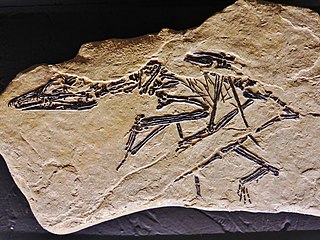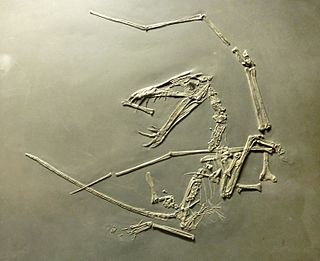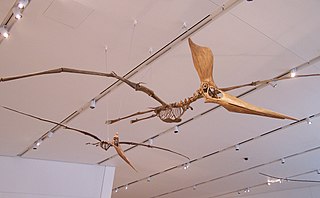
Pterodactylus is a genus of extinct pterosaurs. It is thought to contain only a single species, Pterodactylus antiquus, which was the first pterosaur to be named and identified as a flying reptile and one of the first prehistoric reptiles to ever be discovered.

Pteranodon is a genus of pterosaur that included some of the largest known flying reptiles, with P. longiceps having a wingspan of over 6 m (20 ft). They lived during the late Cretaceous geological period of North America in present-day Kansas, Nebraska, Wyoming, South Dakota and Alabama. More fossil specimens of Pteranodon have been found than any other pterosaur, with about 1,200 specimens known to science, many of them well preserved with nearly complete skulls and articulated skeletons. It was an important part of the animal community in the Western Interior Seaway.

Quetzalcoatlus is a genus of azhdarchid pterosaur that lived during the Maastrichtian age of the Late Cretaceous in North America. The type specimen, recovered in 1971 from the Javelina Formation of Texas, United States, consists of several wing fragments and was described as Quetzalcoatlus northropi in 1975 by Douglas Lawson. The first part of the name refers to the Aztec serpent god of the sky, Quetzalcōātl, while the second part honors Jack Northrop, designer of a tailless fixed-wing aircraft. The remains of a second species were found between 1972 and 1974, also by Lawson, around 40 km (25 mi) from the Q. northropi locality. In 2021, these remains were assigned the name Quetzalcoatlus lawsoni by Brian Andres and (posthumously) Wann Langston Jr, as part of a monograph on the genus.

Rhamphorhynchus is a genus of long-tailed pterosaurs in the Jurassic period. Less specialized than contemporary, short-tailed pterodactyloid pterosaurs such as Pterodactylus, it had a long tail, stiffened with ligaments, which ended in a characteristic soft-tissue tail vane. The mouth of Rhamphorhynchus housed needle-like teeth, which were angled forward, with a curved, sharp, beak-like tip lacking teeth, indicating a diet mainly of fish; indeed, fish and cephalopod remains are frequently found in Rhamphorhynchus abdominal contents, as well as in their coprolites.

Preondactylus is a genus of long-tailed pterosaurs from the Late Triassic that inhabited what is now Italy. It contains a single known species, Preondactylus buffarinii, which was discovered by Nando Buffarini in 1982 at the Forni Dolostone near Udine in the Preone valley of the Italian Alps.

Dorygnathus was a genus of rhamphorhynchid pterosaur that lived in Europe during the Early Jurassic period, when shallow seas flooded much of the continent. It had a short wingspan around 1.5 meters, and a relatively small triangular sternum, which is where its flight muscles attached. Its skull was long and its eye sockets were the largest opening therein. Large curved fangs that "intermeshed" when the jaws closed featured prominently at the front of the snout while smaller, straighter teeth lined the back.

Arambourgiania is a genus of azhdarchid pterosaur that lived during the Maastrichtian age of the Late Cretaceous, in what is now Jordan. Additional fossil remains from the United States and Morocco have also been found, but their assignment to Arambourgiania is only tentative. The original specimen was discovered in the 1940s by a railway worker near Russeifa, Jordan. After examination by paleontologist Camille Arambourg, a new species was named in 1959, Titanopteryx philadelphiae. The generic name means "titan wing", as the fossil was initially misidentified as a huge wing metacarpal, while the specific name refers to the ancient name of Amman, Philadelphia. The genus "Titanopteryx" would later be problematic, as it had already been taken by a fly. Because of this, paleontologist Lev Nessov in 1989 named a new genus, Arambourgiania, in honor of Arambourg. The new species was now known as Arambourgiania philadelphiae.

Campylognathoides is an extinct genus of pterosaur discovered in the Württemberg Lias deposits of Germany; this first specimen however, consisted only of wing fragments. Further better preserved specimens were found in the Holzmaden shale; based on these specimens, Felix Plieninger erected a new genus.

Gnathosaurus is a genus of ctenochasmatid pterosaur containing two species: G. subulatus, named in 1833 from the Solnhofen Limestone of Germany, and G. macrurus, known from the Purbeck Limestone of the UK. Its fossil remains dated back to the Late Jurassic period.

Noripterus is a genus of dsungaripterid pterodactyloid pterosaur from Lower Cretaceous-age Lianmuqin Formation in the Junggar Basin of Xinjiang, China. It was first named by Yang Zhongjian in 1973. Additional fossil remains have been recovered from Tsagaantsav Svita, Mongolia.
Rhamphinion is a genus of pterosaurs from the Sinemurian-mid Pliensbachian-age Lower Jurassic Kayenta Formation of northeastern Arizona, United States. The type species is R. jenkinsi.

The Rocky Mountain Dinosaur Resource Center is a fossil museum primarily exhibiting fossil organisms of North America's Late Cretaceous including dinosaurs, pterosaurs, marine reptiles, and fish. The museum includes a fossil preparation lab and a large gift shop. Live tours are delivered by visitor experience guides highlighting the history of the individual specimens as well as the paleontology of the fossil species they represent. The RMDRC is headquarters to its parent company, Triebold Paleontology Incorporated.

Pteranodon sternbergi is an extinct species of the pteranodontid pterodactyloid pterosaur genus Pteranodon from the Late Cretaceous geological period of North America. P. sternbergi was among the largest pterosaurs, with a wingspan of up to 6 metres (20 ft) in males. It has been argued that P. sternbergi should be classified in a separate genus, Geosternbergia, but this has not been followed by most other researchers.
Paleontology or palaeontology is the study of prehistoric life forms on Earth through the examination of plant and animal fossils. This includes the study of body fossils, tracks (ichnites), burrows, cast-off parts, fossilised feces (coprolites), palynomorphs and chemical residues. Because humans have encountered fossils for millennia, paleontology has a long history both before and after becoming formalized as a science. This article records significant discoveries and events related to paleontology that occurred or were published in the year 1856.
Paleontology or palaeontology is the study of prehistoric life forms on Earth through the examination of plant and animal fossils. This includes the study of body fossils, tracks (ichnites), burrows, cast-off parts, fossilised feces (coprolites), palynomorphs and chemical residues. Because humans have encountered fossils for millennia, paleontology has a long history both before and after becoming formalized as a science. This article records significant discoveries and events related to paleontology that occurred or were published in the year 1839.

The Paleozoological Museum of China is a museum in Beijing, China. The same building also houses the Institute of Vertebrate Paleontology and Paleoanthropology of the Chinese Academy of Sciences. The museum contains exhibition halls with specimens aimed at the public, while the rest of the building is used for research purposes.
Paleontology or palaeontology is the study of prehistoric life forms on Earth through the examination of plant and animal fossils. This includes the study of body fossils, tracks (ichnites), burrows, cast-off parts, fossilised feces (coprolites), palynomorphs and chemical residues. Because humans have encountered fossils for millennia, paleontology has a long history both before and after becoming formalized as a science. This article records significant discoveries and events related to paleontology that occurred or were published in the year 1843.
Paleontology or palaeontology is the study of prehistoric life forms on Earth through the examination of plant and animal fossils. This includes the study of body fossils, tracks (ichnites), burrows, cast-off parts, fossilised feces (coprolites), palynomorphs and chemical residues. Because humans have encountered fossils for millennia, paleontology has a long history both before and after becoming formalized as a science. This article records significant discoveries and events related to paleontology that occurred or were published in the year 1830.
Gwawinapterus beardi is a species of saurodontid ray-finned fish from the Late Cretaceous period of British Columbia, Canada. While initially described as a very late-surviving member of the pterosaur family Istiodactylidae, further examination has cast doubt on the identification of the specimen as a pterosaur, and research published in 2012 identified the remains as having come from a saurodontid fish.

This timeline of pterosaur research is a chronologically ordered list of important fossil discoveries, controversies of interpretation, and taxonomic revisions of pterosaurs, the famed flying reptiles of the Mesozoic era. Although pterosaurs went extinct millions of years before humans evolved, humans have coexisted with pterosaur fossils for millennia. Before the development of paleontology as a formal science, these remains would have been interpreted through a mythological lens. Myths about thunderbirds told by the Native Americans of the modern Western United States may have been influenced by observations of Pteranodon fossils. These thunderbirds were said to have warred with water monsters, which agrees well with the co-occurrence of Pteranodon and the ancient marine reptiles of the seaway over which it flew.














